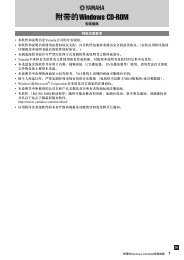You also want an ePaper? Increase the reach of your titles
YUMPU automatically turns print PDFs into web optimized ePapers that Google loves.
WARNING<br />
PRECAUTIONS<br />
PLEASE READ CAREFULLY BEFORE PROCEEDING<br />
* Please keep this manual in a safe place for future reference.<br />
Always follow the basic precautions listed below to avoid the possibility of serious injury or even death<br />
from electrical shock, short-circuiting, damages, fire or other hazards. These precautions include, but<br />
are not limited to, the following:<br />
Power supply/Power cord<br />
• Only use the voltage specified as correct for the instrument.<br />
The required voltage is printed on the name plate of the<br />
instrument.<br />
• Check the electric plug periodically and remove any dirt or<br />
dust which may have accumulated on it.<br />
• Use only the supplied power cord/plug.<br />
• Do not place the power cord near heat sources such as<br />
heaters or radiators, and do not excessively bend or otherwise<br />
damage the cord, place heavy objects on it, or place it in a<br />
position where anyone could walk on, trip over, or roll anything<br />
over it.<br />
Do not open<br />
• Do not open the instrument or attempt to disassemble the<br />
internal parts or modify them in any way. The instrument<br />
contains no user-serviceable parts. If it should appear to be<br />
malfunctioning, discontinue use immediately and have it<br />
inspected by qualified <strong>Yamaha</strong> service personnel.<br />
CAUTION<br />
• Do not expose the instrument to rain, use it near water or in<br />
damp or wet conditions, or place containers on it containing<br />
liquids which might spill into any openings.<br />
• Never insert or remove an electric plug with wet hands.<br />
• Do not put burning items, such as candles, on the unit.<br />
A burning item may fall over and cause a fire.<br />
• If the power cord or plug becomes frayed or damaged, or if<br />
there is a sudden loss of sound during use of the instrument,<br />
or if any unusual smells or smoke should appear to be caused<br />
by it, immediately turn off the power switch, disconnect the<br />
electric plug from the outlet, and have the instrument<br />
inspected by qualified <strong>Yamaha</strong> service personnel.<br />
Always follow the basic precautions listed below to avoid the possibility of physical injury to you or<br />
others, or damage to the instrument or other property. These precautions include, but are not limited<br />
to, the following:<br />
Power supply/Power cord<br />
• When removing the electric plug from the instrument or an<br />
outlet, always hold the plug itself and not the cord. Pulling by<br />
the cord can damage it.<br />
• Remove the electric plug from the outlet when the instrument<br />
is not to be used for extended periods of time, or during<br />
electrical storms.<br />
• Do not connect the instrument to an electrical outlet using a<br />
multiple-connector. Doing so can result in lower sound quality,<br />
or possibly cause overheating in the outlet.<br />
Assembly<br />
• Read carefully the attached documentation explaining the<br />
assembly process. Failure to assemble the instrument in the<br />
proper sequence might result in damage to the instrument or<br />
even injury.<br />
(1)B-7<br />
Water warning<br />
Fire warning<br />
If you notice any abnormality<br />
• Do not expose the instrument to excessive dust or vibrations,<br />
or extreme cold or heat (such as in direct sunlight, near a<br />
heater, or in a car during the day) to prevent the possibility of<br />
panel disfiguration or damage to the internal components.<br />
• Do not use the instrument in the vicinity of a TV, radio, stereo<br />
equipment, mobile phone, or other electric devices.<br />
Otherwise, the instrument, TV, or radio may generate noise.<br />
• Do not place the instrument in an unstable position where it<br />
might accidentally fall over.<br />
• Before moving the instrument, remove all connected cables.<br />
• Do not place the instrument against a wall (allow at least 3 cm/<br />
one-inch from the wall), since this can cause inadequate air<br />
circulation, and possibly result in the instrument overheating.<br />
1/2<br />
Location<br />
<strong>CLP</strong>-<strong>170</strong>/<strong>150</strong><br />
3




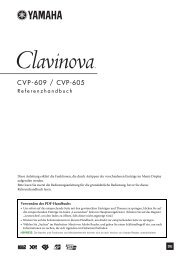

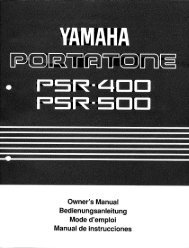

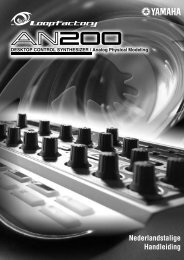
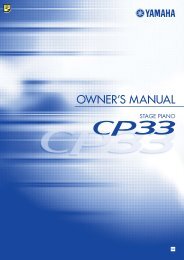


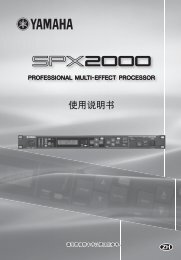
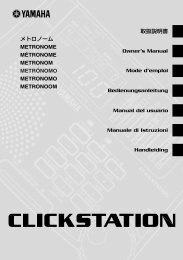
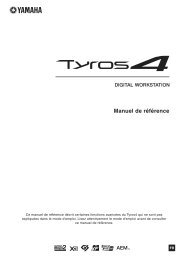
![Premere il pulsante [SONG] - Yamaha](https://img.yumpu.com/50419553/1/184x260/premere-il-pulsante-song-yamaha.jpg?quality=85)
